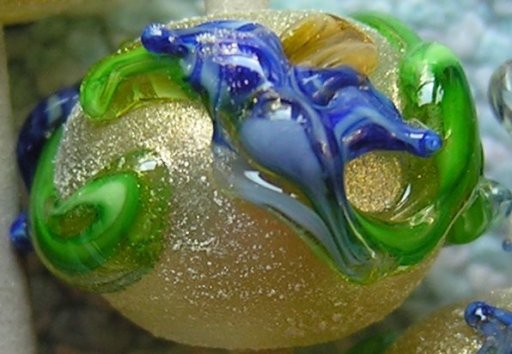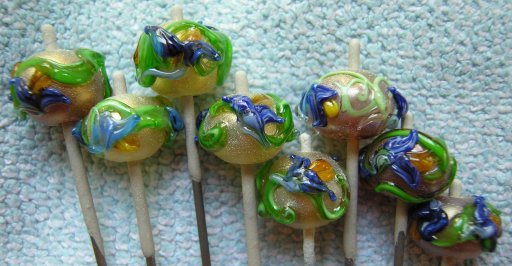One thing about posting all the time—it's made me shameless. Here's another set of extremely mediocre beads. I was attempting two objectives, and succeeded on only a very limited basis with either:
One was to find a background for that dark blue floral cane. It actually looks decent on the amber, but flowers simply don't come in that color, which along with poor form, sets up a cognative dissonance—in plain terms, makes it look as if I don't have a clue about florals. Ah well...
The other problem is the form of the flower itself. Probably the easiest of all flowers is the slop it on circular; next is the rounded petal tips coming to a point at the flower's base, (which is what I typically do as for crocus and the like.)

I've softened the base of the flower with a little bit of trailing in lighter blue, to join it visually more effectively to the stem.
Here I'm trying to do the opposite: make flowers with petals that are rounded at the base and pointy at the tip—real life examples would be species tulips, or the wood hyacinths that inspired these beads. In either case the basic movement is the same: you heat the end of a thin stringer till molten (i.e. balled up slightly), touch the ball to the surface of the glass, usually ‘backing up’ a tiny bit before pushing (down on the stringer) sharply (while simultaneously pulling across the bead surface) along the petal's axis, finally pulling up and off to a point. You need a little heat to cut off that tip, there, but otherwise, once the stringer is heated, the bead is out of the flame, which will melt your petal's crisp edges—a lot of the charm of this technique—to mush in short order. The stiff center of the rod can actually create a crease down the center of your petal (or leaf) if your heat control is sufficient.
Needless to say, one generally wants to have the torch turned down for this techique. But varying the ‘backup’ (which gives the roundedness) and the direction of the pull, you can twist petals (as shown here), or make two side-by-side, coming to a point, for a more dramatically divided leaf. If the rod doesn't provide sufficient sharpness for the tip as you make the petal, then you can either use a metal tool or a short thread/tip on a stringer to rake the petal to a point. Some people even use fine tweezers (#5 forceps) to pull their petals to points, but that involves picking up a tool, so, lazy as I am, I don't typically do it. Besides, I find pulling off excess glass (which I usally want to do when raking to a tip) easier with a stringer; glass sticks to itself.
Other variations are documented in Jim Kervin's book on Leah Fairbanks; and I note, using ribbon shaped stringer, as opposed to round, also allows for some fun variations on this style of trailing.
hollow mandrel wound beads created 18may2005, roughly 10–13mm diameter. Effetre glass, pixie dust. Post created 21may05
Unless otherwise noted, text, image and objects depicted therein copyright 1996--present sylvus tarn.
Sylvus Tarn